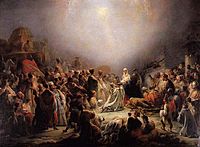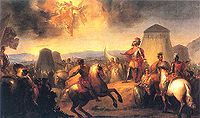- Domingos Sequeira
-
Domingos António de Sequeira (10 March 1768 – 8 March 1837), was a Portuguese painter.
Biography
He was born in Belém, Lisbon, into a modest family. He later changed his family name from Espírito Santo to the more aristocratic Sequeira. He studied art first at the academy of Lisbon, before moving to Rome, were he was Antonio Cavallucci`s pupil.
By the age of thirteen, he had evinced such marked talent that F. de Setubal employed him as assistant in his work for the João Ferreiras Palace. Sequeira sojourned in Rome from 1788 to 1794, when he was made honorary member of the Academy of St Luke. After another two years and study in Italy, he returned to his native country preceded by so great a reputation that important commissions for churches and palaces were immediately entrusted to him: scriptural subjects, large historical compositions and cabinet pictures.[1]
In 1802 he was appointed first court painter, in which capacity he executed many works for the prince regent, for Dona Maria Teresa, and for the members of the court. He designed the valuable silver service which was presented by the Portuguese nation to Wellington,[2] and a monument that was erected in 1820 in the Rossio square at Lisbon.[1] In 1823 he visited Paris, where he is known to have tried his skill in lithography and etching. In 1825, he painted the "Death of Camões", by many considered the first proto-romantic or romantic Portuguese painting. The last years of his life he spent in Rome, devoting himself chiefly to devotional subjects and to his duties as head of the Portuguese Academy. He saw a Turner exposition in the late 1820s, that inspired him some of his best paintings, like the "Adoração dos Magos" (1828). He died in Rome in 1837.
Works
Among his best-known pictures are the "Flight into Egypt," "Ugolino," the "St Bruno at Prayer" at the Lisbon Academy, and the "Descent from the Cross."[1] Numerous paintings by Sequeira are in the royal palace at Mafra, the convent of Laveinas, the new palace of Ajuda, and in the principal palaces and churches of Lisbon. The Museu Nacional de Arte Antiga (National Museum of Ancient Art), in Lisbon, has one of the best collections of his paintings.
References
- ^ a b c
 Chisholm, Hugh, ed (1911). "Sequeira, Domingo Antonio de". Encyclopædia Britannica (11th ed.). Cambridge University Press.
Chisholm, Hugh, ed (1911). "Sequeira, Domingo Antonio de". Encyclopædia Britannica (11th ed.). Cambridge University Press. - ^ Heath, Diana. "Portugal's Silver Service". Victoria and Albert Museum. http://www.vam.ac.uk/res_cons/conservation/journal/number_17/portuguese_centrepiece/index.html. Retrieved 30 October 2010.
- José-Augusto França, A Arte em Portugal no Século XIX, Lisboa, Bertrand Editora, 1991, volume 1.
Categories:- 1768 births
- 1837 deaths
- Portuguese neoclassical painters
- ^ a b c
Wikimedia Foundation. 2010.


